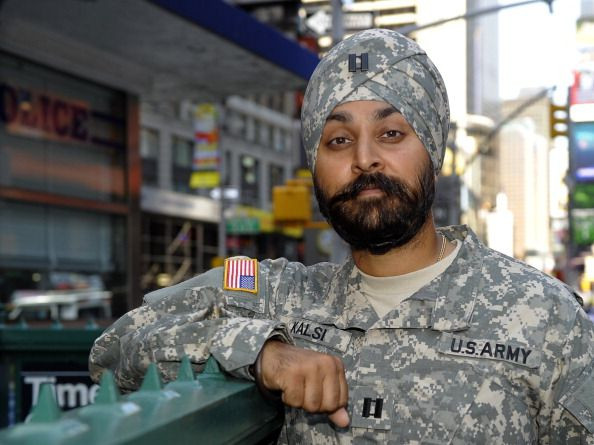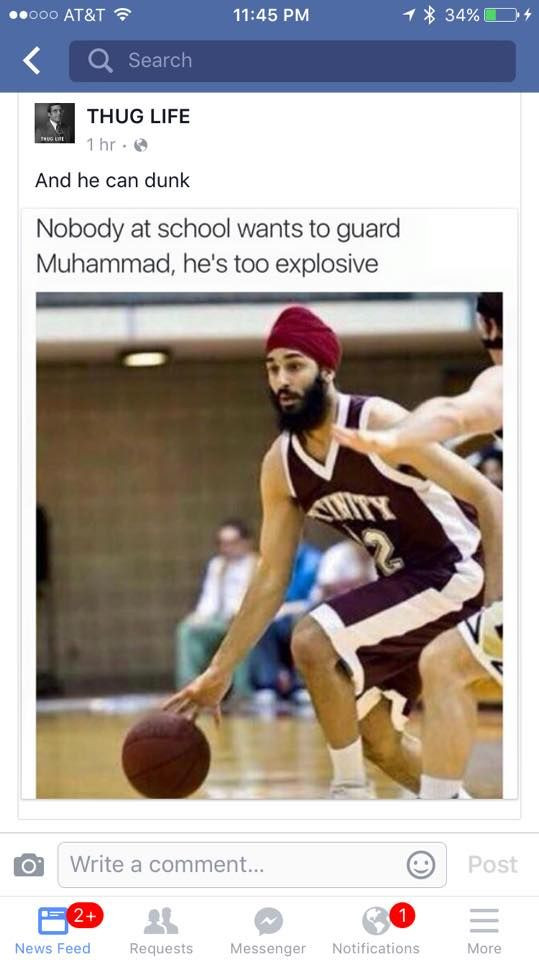Sikh-Americans Suffer Racist Abuse After San Bernardino: 'He's Too Explosive'

Darsh Singh, 29, hasn’t played basketball at Trinity University since he graduated in 2008. But a picture of him in his jersey, featuring a crass caption that reads “Nobody at school wants to guard Muhammad, he’s too explosive,” has been making the rounds on the internet for years. It resurfaced in recent weeks in the wake of the Paris and San Bernardino, California, attacks.
Singh, who wears a turban and sports a beard, is not Muslim. He practices Sikhism, a monotheistic religion that originated in India in the 15th century and has about 27 million adherents worldwide. Last year, his college jersey was put on display in the Smithsonian Institution to mark him as the first turbaned Sikh to play basketball in the NCAA. He says he’s used to seeing the meme online and that, while it’s hurtful, he chooses not to respond, opting to let his actions speak for themselves.

But last week, his friend Greg Worthington came across the meme and decided he couldn’t stay silent. Instead, he posted the picture on Facebook with a lengthy post about his friend and how such memes are inappropriate and harmful.
“Even if I didn't know Darsh, I still wouldn't think this was funny. Why? Because things like this pic teach people to be afraid of those who are different than you,” wrote Worthington. His post went viral, garnering nearly 40,000 likes -- and inspiring the hashtag #BeLikeDarsh in which people share their own stories of rising above hate.
Darsh Singh is not the first Sikh-American to be targeted for his appearance and religion. During a time when anti-Muslim sentiment is on the rise, other unfamiliar religious groups and ethnicities are caught in the cross fire. Sikhs, whose men wear turbans and beards as a part of their religious identity, have been frequent victims since 9/11. The community is seeing a surge in such discrimination in recent weeks as a result, they say, of anti-Muslim rhetoric and the “otherization” of minority groups.
“It’s not a new phenomenon -- Sikhs have been targeted since we first came to this country. But we’re definitely seeing a surge, especially during moments of social and political unrest like this one,” said Simran Jeet Singh, a professor of religion at Trinity University and a fellow at the Sikh Coalition, an advocacy group.
“For us, it’s a two-step response. First, we tell people, we’re not Muslim, and we’d like you to know who we are. Second, even if we were Muslim, it’s not right to target people based on what they believe. So we have to educate people about our community, but also take a stand against bigotry in general,” he said.
San Antonio Sikhs hold open house to introduce religion, address rise of hate violence. https://t.co/pqLwFMzvMo pic.twitter.com/ffkvG5G6N6
— Simran Jeet Singh (@SikhProf) December 14, 2015Singh adds that it’s hard to quantify hate crimes against Sikhs because, up until last year, the FBI didn’t track them in a separate category, lumping them in with hate crimes against Muslims. But reports of violence and harassment against the Sikh community, which numbers about 500,000 in the United States, have increased in recent months.
Last week, the largest Sikh temple, or gurdwara, in the metro Los Angeles area was vandalized, and a truck parked out front was painted with slurs like “F*** ISIS.” Sikh football fans trying to attend a San Diego Chargers game at Qualcomm Stadium last Sunday said they were not allowed to enter because of their turbans. A Sikh bus driver who attends the temple that was vandalized in L.A. was punched by a passenger who shouted something about metro buses being hijacked by terrorists. Last September, a Sikh-American taxi driver in Chicago faced a violent assault by a teenager who pummeled him, yelling “Bin Laden” during the attack. And in 2012, a gunman killed six people in a Sikh temple in Oak Creek, Wisconsin, before shooting himself.
“This is what Sikhs are facing right now. It’s very demoralizing and humiliating,” said Inderjot Singh, 32, president of the Gurdwara Singh Sabha in Buena Park, California, that was vandalized. “We’ve added security cameras and hired a private security firm to be on site during our services on Wednesdays and Sundays. We have about 200 kids in the building on Sunday and we don’t want to take any chances.”
CA: #Sikh Gurdwara Vandalized in Los Angeles With Anti-ISIS Graffiti #EndHate #Islamophobia https://t.co/PKGjSahy4x pic.twitter.com/nixZw9rcjO
— Hatewatch (@Hatewatch) December 10, 2015
Darsh Singh, the former basketball player, says that memes like the one created with his picture are a precursor to such violence. “They perpetuate stereotypes that are dangerous and outright false,” he said. “Hate on the airwaves results in hate on the ground.”
That’s why it’s important for people of all faiths to stand up against hate when they see it, he said. He was particularly moved by his friend, who was driven by his Christian faith to speak out on his behalf.
“Greg’s commitment to his Christian values compelled him to speak up when he saw something he felt was wrong. By voicing his thoughts, he was combating hate, fear and ignorance through education,” Singh wrote in an op-ed for his hometown newspaper, the Dallas Morning News.
© Copyright IBTimes 2025. All rights reserved.





















